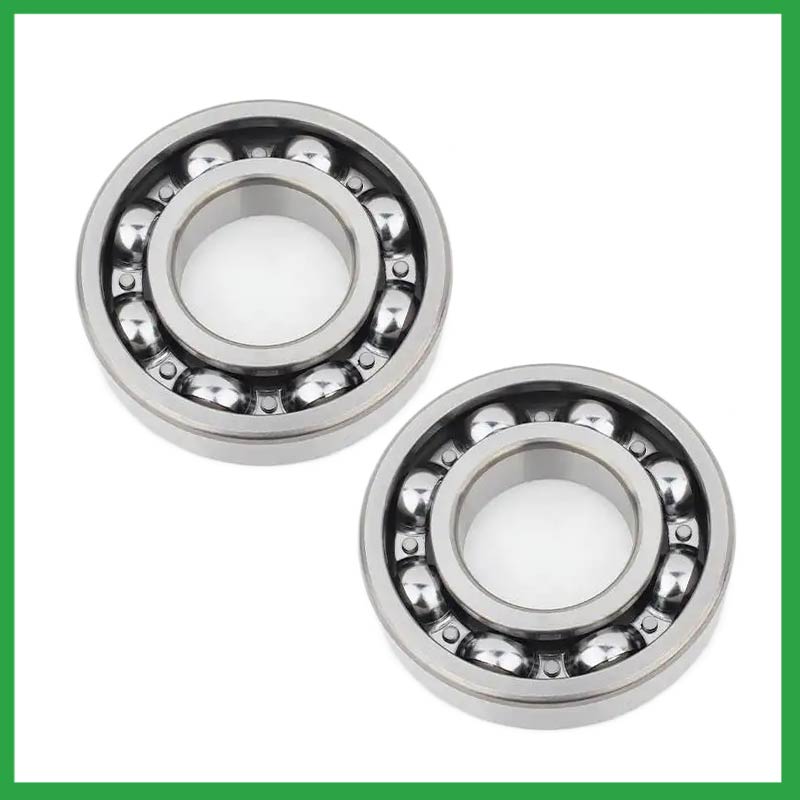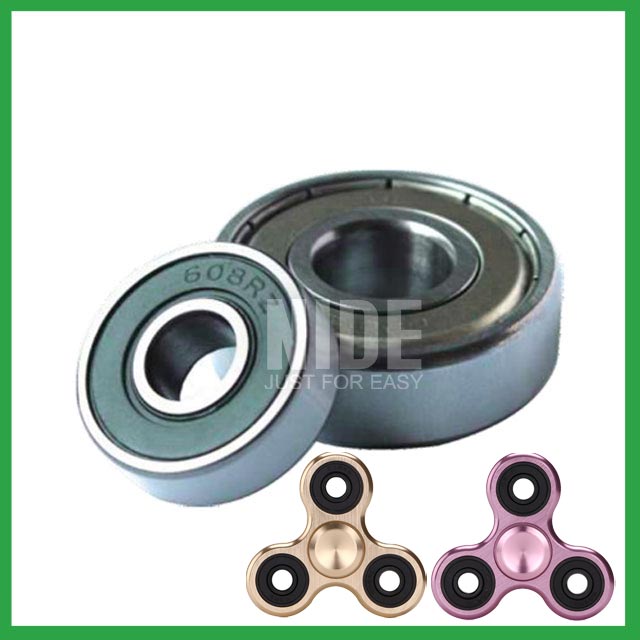2024-03-07
Ningbo Haishu Nide International Co., Ltd produces and supplies ball bearings.We have professional technical manpower for the mixing of polymer raw materials for the insulation coating of bearings, production of products, and quality control. We will grow together with customers with accurate quality, fast delivery and competitive prices.
In years of practice, we have established a strict quality assurance system. Our product range covers insulation paper,magnet,carbon brush,commutator,shaft,thermal protector,fan,deep groove ball bearings, spherical roller bearings,ball bearing,motor cover and lamination, etc. They are widely used in fields such as electric automotive motor,fan motor,washing machine motor,BLDC motor,air condition motor,compress motor,water pump motor,electric bicycle motor,single and three phase induction motor,servo motor. We can produce OEM products and make the following drawings. Our principle is to prioritize service and quality!
ball bearing---FAQs Guide
1.What scenarios are suitable for matching bearings?
1. High Load Applications: Matching bearings are suitable for applications where there is a high load or heavy weight that needs to be supported. This could include heavy machinery, construction equipment, or vehicles.
2. Precision Machinery: In precision machinery, such as machine tools or medical equipment, matching bearings are necessary to ensure smooth and accurate movement of components.
3. High Speed Applications: Matching bearings are also suitable for high-speed applications, such as in turbines, compressors, or electric motors. They can help reduce friction and maintain stability at high speeds.
4. Variable Load Applications: In applications where the load varies, such as in conveyor systems or cranes, matching bearings can help distribute the load evenly and prevent premature wear.
5. Harsh Environments: Matching bearings are suitable for use in harsh environments, such as extreme temperatures, corrosive chemicals, or heavy vibrations. They can provide better protection and durability in these conditions.
6. Customized Designs: In some cases, standard bearings may not be suitable for a specific application. Matching bearings can be customized to meet the specific requirements of the application, such as size, load capacity, or material.
7. Cost Savings: Matching bearings can help reduce costs by optimizing the use of bearings in an application. By selecting the right combination of bearings, it is possible to achieve the same performance with fewer bearings, reducing maintenance and replacement costs.
8. Complex Systems: In complex systems with multiple moving parts, matching bearings can help ensure proper alignment and reduce the risk of failure or damage to components.
9. High Precision and Accuracy: In applications where precision and accuracy are critical, such as in aerospace or defense equipment, matching bearings are necessary to maintain tight tolerances and ensure reliable performance.
10. Retrofitting or Upgrading: Matching bearings can be used when retrofitting or upgrading existing equipment to improve performance or extend its lifespan. They can be designed to fit into the existing system without major modifications.
2.What are the main materials of ball bearings?
We have a wide range of ball bearing customer groups and establishes long -term cooperative relationships with partners. The countries we provide services include Albania,Cape Verde,Gambia,Lesotho,Ghana.
1. Steel: The most common material used for ball bearings is steel, specifically high carbon chromium steel. This type of steel is strong, durable, and can withstand high temperatures and pressures.
2. Ceramic: Ceramic ball bearings are becoming increasingly popular due to their high strength, low density, and resistance to corrosion and wear. They are often used in high-speed and high-temperature applications.
3. Stainless steel: Stainless steel ball bearings are used in applications where corrosion resistance is important, such as in the food and medical industries. They are also commonly used in marine and outdoor equipment.
4. Plastic: Plastic ball bearings are lightweight, corrosion-resistant, and have low friction. They are often used in applications where weight and cost are important factors, such as in consumer products and automotive components.
5. Brass: Brass ball bearings are commonly used in low-speed and low-load applications, such as in furniture and door hinges. They are also used in some electrical and plumbing applications.
6. Bronze: Bronze ball bearings are similar to brass bearings but are stronger and more durable. They are often used in heavy-duty industrial applications, such as in mining and construction equipment.
7. Glass: Glass ball bearings are used in specialized applications, such as in laboratory equipment and precision instruments. They are also used in some high-temperature and corrosive environments.
8. Tungsten carbide: Tungsten carbide ball bearings are extremely hard and wear-resistant, making them suitable for high-load and high-speed applications, such as in pumps and compressors.
9. Titanium: Titanium ball bearings are lightweight, strong, and corrosion-resistant. They are often used in aerospace and military applications.
10. Hybrid: Hybrid ball bearings combine different materials, such as steel and ceramic, to take advantage of their individual properties. They are often used in high-performance applications, such as in racing cars and bicycles.
3.What scenarios are high-speed ball bearings suitable for?
We should have a stable supply chain and logistics capabilities, and provide customers with high -quality, low -priced ball bearing products.
1. Automotive Industry: High-speed ball bearings are commonly used in the automotive industry for various applications such as engine components, transmissions, and wheel bearings.
2. Aerospace Industry: In the aerospace industry, high-speed ball bearings are used in aircraft engines, landing gear systems, and other critical components that require high-speed rotation.
3. Industrial Machinery: High-speed ball bearings are essential in industrial machinery such as pumps, compressors, and turbines, where high speeds and precision are required.
4. Medical Equipment: High-speed ball bearings are used in medical equipment such as dental drills, surgical tools, and imaging machines, where precision and high speeds are crucial.
5. Robotics: High-speed ball bearings are used in robotics for various applications, including robotic arms, joints, and other moving parts that require high-speed and precision.
6. Power Tools: High-speed ball bearings are commonly used in power tools such as drills, grinders, and saws, where high speeds and precision are necessary for efficient operation.
7. Sports Equipment: High-speed ball bearings are used in sports equipment such as skateboards, rollerblades, and bicycles, where high speeds and smooth rotation are essential for performance.
8. Printing Industry: High-speed ball bearings are used in printing machines for high-speed rotation of printing rollers, ensuring precise and efficient printing.
9. Wind Turbines: High-speed ball bearings are used in wind turbines for the rotation of blades, which require high speeds and precision for efficient energy production.
10. Marine Industry: High-speed ball bearings are used in marine equipment such as propellers, pumps, and generators, where high speeds and precision are crucial for smooth operation.
4.As a ball bearing manufacturer,can you supply samples?
Sure, samples can be provided free of charge, and the buyer pay the postage of the sample.

5.What are the accuracy levels of ball bearings?
We have a good reputation and image in the industry. The quality and price advantage of ball bearing products is an important factor in our hard overseas market. The accuracy levels of ball bearings can vary depending on the type and application of the bearing. Generally, ball bearings have accuracy levels ranging from ABEC-1 (lowest) to ABEC-9 (highest). ABEC stands for Annular Bearing Engineering Committee and is a standard used to measure the precision and tolerance of ball bearings.
The accuracy levels of ball bearings are typically measured in microns (μm) or millionths of an inch (mil). For example, an ABEC-1 bearing has an accuracy level of 0.0005 inches or 12.7 microns, while an ABEC-9 bearing has an accuracy level of 0.000001 inches or 0.0254 microns.
In addition to ABEC ratings, there are also other standards used to measure the accuracy of ball bearings, such as ISO (International Organization for Standardization) and DIN (Deutsches Institut für Normung). These standards may use different measurement units and have different accuracy levels compared to ABEC ratings.
It is important to note that the accuracy level of a ball bearing does not necessarily determine its overall quality or performance. Other factors such as material, lubrication, and design also play a significant role in the performance of a ball bearing.
6.About ball bearing,Can I add my own logo?
Yes, you can add your logo on bearings and packing box. We supply OEM SERVICE including bearing's size, logo, packing, etc.
7.What are the advantages of ball bearings compared to linear bearings?
We focus on teamwork and communication to achieve common goals, We attach great importance to this detail.
1. Lower Friction: Ball bearings have a lower coefficient of friction compared to linear bearings, which means they require less force to move and can operate more smoothly.
2. Higher Load Capacity: Ball bearings can handle higher loads than linear bearings, making them suitable for heavy-duty applications.
3. Reduced Wear and Tear: The rolling motion of ball bearings reduces wear and tear on the bearing and the surface it is moving on, increasing their lifespan.
4. Lower Noise and Vibration: Ball bearings produce less noise and vibration compared to linear bearings, making them ideal for applications where noise and vibration are a concern.
5. Self-Alignment: Ball bearings are self-aligning, which means they can accommodate misalignment between the shaft and the housing, ensuring smooth operation.
6. Compact Design: Ball bearings have a smaller footprint compared to linear bearings, making them suitable for applications with limited space.
7. Cost-Effective: Ball bearings are generally more cost-effective than linear bearings, making them a popular choice for many applications.
8. Easy to Install: Ball bearings are relatively easy to install and require minimal maintenance, making them a convenient option for many applications.
9. Wide Range of Sizes and Types: Ball bearings are available in a wide range of sizes and types, making them suitable for various applications and industries.
10. Versatility: Ball bearings can be used in both radial and axial applications, providing versatility and flexibility in design and use.
8.What scenarios are simplified ball bearings suitable for?
1. Low Load Applications: Simplified ball bearings are suitable for applications with low loads, where the weight of the load is not significant enough to cause excessive wear on the bearings.
2. Low Speed Applications: These bearings are ideal for low-speed applications, where the rotational speed is not very high. They can handle slower speeds without causing excessive friction or heat buildup.
3. Light Duty Machinery: Simplified ball bearings are commonly used in light-duty machinery, such as household appliances, office equipment, and small electric motors.
4. Agricultural Equipment: These bearings are suitable for use in agricultural equipment, such as tractors, harvesters, and other farm machinery.
5. Conveyor Systems: Simplified ball bearings are commonly used in conveyor systems, where they can handle light loads and low speeds.
6. Automotive Applications: These bearings are suitable for use in automotive applications, such as steering systems, wheel hubs, and transmissions.
7. Household and Recreational Equipment: Simplified ball bearings are commonly used in household and recreational equipment, such as bicycles, skateboards, and roller skates.
8. Medical Equipment: These bearings are suitable for use in medical equipment, such as hospital beds, wheelchairs, and surgical instruments.
9. Packaging Machinery: Simplified ball bearings are commonly used in packaging machinery, such as filling machines, labeling machines, and sealing machines.
10. Textile Machinery: These bearings are suitable for use in textile machinery, such as spinning machines, weaving machines, and knitting machines.

Products Tag: 608 Deep groove ball carbon steel bearing for Fingertip spinner and roller skating